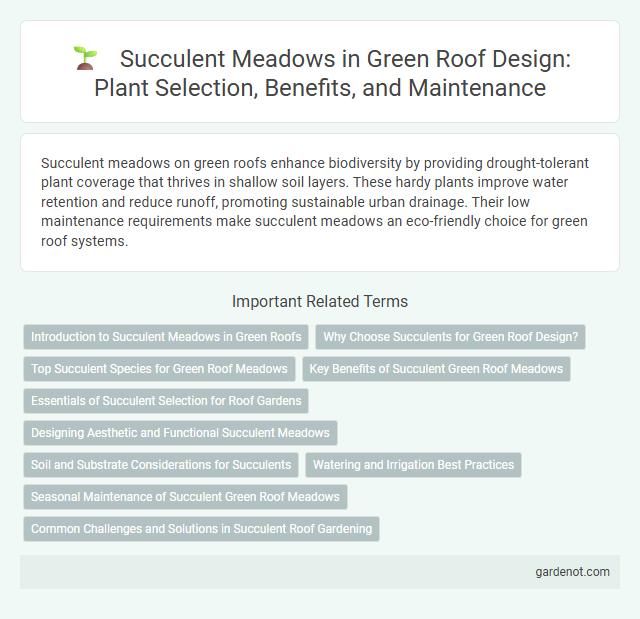Succulent meadows on green roofs enhance biodiversity by providing drought-tolerant plant coverage that thrives in shallow soil layers. These hardy plants improve water retention and reduce runoff, promoting sustainable urban drainage. Their low maintenance requirements make succulent meadows an eco-friendly choice for green roof systems.
Introduction to Succulent Meadows in Green Roofs
Succulent meadows on green roofs consist of drought-tolerant plants like sedums, sempervivums, and echeverias that thrive in shallow growing media and withstand extreme weather conditions. These plants store water in their leaves, reducing irrigation needs and enhancing rooftop biodiversity while mitigating urban heat island effects. Incorporating succulent meadows improves green roof longevity through minimal maintenance and resilient coverage.
Why Choose Succulents for Green Roof Design?
Succulents offer exceptional drought tolerance and low maintenance, making them ideal for green roof applications where water conservation is crucial. Their shallow root systems and ability to retain moisture reduce soil erosion and support roof longevity. The diverse species and vibrant textures of succulents enhance aesthetic appeal while promoting biodiversity on urban rooftops.
Top Succulent Species for Green Roof Meadows
Top succulent species for green roof meadows include Sedum album, Sedum spurium, and Sedum acre, prized for their drought tolerance and shallow root systems. These species enhance biodiversity while providing efficient water retention and minimal maintenance requirements. Integrating succulents like Sempervivum and Delosperma further improves resilience and aesthetic appeal on green rooftops.
Key Benefits of Succulent Green Roof Meadows
Succulent green roof meadows provide exceptional drought resistance and water retention, reducing stormwater runoff and lowering irrigation needs. These meadows enhance urban biodiversity by supporting pollinators and creating microhabitats for diverse insect species. Their lightweight structure minimizes roof load, making them an ideal sustainable solution for energy efficiency and thermal insulation in buildings.
Essentials of Succulent Selection for Roof Gardens
Succulent meadows on green roofs thrive by selecting drought-tolerant species with shallow root systems like Sedum, Sempervivum, and Echeveria, which efficiently retain moisture and withstand harsh rooftop conditions. Prioritize succulents with varied textures and colors to enhance aesthetic appeal while ensuring resilience to wind, sun exposure, and temperature fluctuations. Optimal soil depth and drainage, combined with low-maintenance, slow-growing varieties, support sustainable growth and long-term roof garden success.
Designing Aesthetic and Functional Succulent Meadows
Designing aesthetic and functional succulent meadows involves selecting diverse drought-tolerant species like Sedum, Echeveria, and Sempervivum that thrive in shallow green roof substrates. Incorporating varying textures, colors, and heights enhances visual appeal while promoting biodiversity and water retention efficiency. Proper layout and soil composition ensure healthy growth, low maintenance, and improved insulation benefits on green roof installations.
Soil and Substrate Considerations for Succulents
Succulent meadows thrive in well-draining soil mixtures composed of coarse sand, perlite, and organic matter, ensuring optimal moisture retention without waterlogging. A substrate pH range of 6.0 to 7.5 supports nutrient availability, while lightweight materials reduce load on green roof structures. Incorporating porous aggregates enhances aeration, preventing root rot and promoting healthy succulent growth.
Watering and Irrigation Best Practices
Succulent meadows on green roofs require minimal watering due to their drought-tolerant properties, making drip irrigation systems ideal for precise moisture delivery. Overwatering can lead to root rot, so irrigation schedules should emphasize deep, infrequent watering during extended dry periods. Monitoring soil moisture levels ensures optimal hydration while conserving water and promoting succulent health.
Seasonal Maintenance of Succulent Green Roof Meadows
Succulent green roof meadows require seasonal maintenance focusing on irrigation adjustments, especially during dry summer months to prevent drought stress. Removing dead or decaying plant material in spring enhances airflow and reduces pest risks, promoting healthy growth for drought-tolerant species like Sedum and Sempervivum. Periodic weeding and light fertilization during early growth phases support robust root development and maintain the meadow's ecological balance.
Common Challenges and Solutions in Succulent Roof Gardening
Succulent meadow green roofs often face challenges such as water retention issues and soil erosion due to the shallow growing medium. Implementing lightweight, well-draining substrates combined with organic amendments enhances moisture management and root stability. Utilizing drought-tolerant succulent species alongside efficient irrigation systems mitigates stress from fluctuating weather conditions and promotes long-term sustainability.
Succulent meadow Infographic

 gardenot.com
gardenot.com